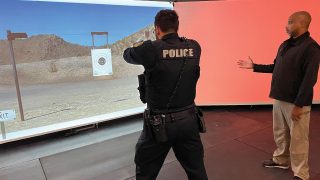
Law enforcement officers make countless life-or-death decisions throughout their careers. To help illustrate the pattern of thinking that goes into decision-making, insight loops and the OODA loops are crucial tools that officers should familiarize themselves with.
Both center on the idea that when we can understand and pay attention to how we think, we can think — and act — more strategically. The loops are different, though, in terms of how they are employed and to what end.
Beyond the way they are depicted visually, the insight loop illustrates the pattern of thinking that goes into decision-making in order to focus officers’ attention on the decision-making motivating conflict behavior. When they do, they position themselves to de-escalate conflict in the moment of enforcement and find solutions that members of the public can comply with. The OODA loop illustrates the same pattern of decision-making, albeit in a slightly different way, to help officers pay attention to their own and others’ decision-making in order to create a tempo that can outmaneuver a criminal target and disrupt their thinking.
It is no wonder that conflict fields — both military conflict and conflict resolution — have looked to theories grounded in critical decision-making to gain a strategic footing. Both fields are deeply concerned with behaviors — in the case of the military, the concern is to subdue behaviors that threaten to dominate or destroy civilians and national interests. In the case of conflict resolution, the concern is to change behaviors that lead to damaging interpersonal or structural interactions. Both fields have gravitated toward illustrations of the cognitive process that leads to action as both an explanatory tool and a roadmap for action in pursuit of strategic ends.
To outline the similarities, let’s take a look at the two loops. John Boyd presented his theory of the OODA loop in the late 20th century in this way: observe, orient, decide, act. The observe step describes our perception. Once we’ve perceived information, we orient ourselves to it. In other words, we draw on our past, our culture, our role and our context to interpret what we’ve observed. From there, we decide how to respond in a way that best achieves our goal. Then, we act. Boyd was careful to incorporate constant feedback into the OODA loop. We are not merely sequential thinkers and doers. We learn, adjust and adapt.
Jamie Price, building off the cognitional philosophy of Bernard Lonergan, developed the insight loop in the early 2010s and included additional steps in descripting the pattern of thinking that leads to decision-making. His loop, which is foundational to the insight approach to conflict analysis and resolution, includes three key moves: knowing, valuing and deciding.
The bottom loop is where we generate a sense that we know. To do this, there are some steps involved. First, we experience data in the world. This is similar to Boyd’s observe. Once we experience data, we spontaneously wonder what it is, generate options for understanding and then verify what is most likely to be true. Once we feel like we know well enough (even if we happen to be mistaken), we spontaneously have a feeling about what we know. This feeling tells us how it is significant to us. This is the valuing stage. Part of valuing — sensing significance — is imagining the impact of what we know. This is what sets us up to respond — to decide to act. Deciding to act also takes a few steps. First, we deliberate options. Then, we evaluate which option will most likely achieve our goal. Finally, we decide to commit to an action. All of this is in response to our valuing — to what we imagine or predict the impact of what we know is.
Like Boyd’s orient, Price depicts that our past, our culture, our role and our context inform each of these steps. Implied in the OODA loop is that we can loop better or worse. This is also represented in the insight loop, where each stage of the loop has a performance range to illustrate that we can think more or less well, and that impacts the adequacy of what we ultimately decide to do.
The similarities are striking, and the loops are compelling, not least because they describe the regular and recurrent pattern in which we use our minds every day. We are constantly interpreting our surroundings and responding in ways that are intended to help us achieve our goals. When we pay attention, we notice that the loops match our experience.
The differences lie in their strategic ends. For Boyd, a military strategist, the goal is to out-think and out-act an adversary. The idea is that if we can understand both our own and another’s pattern of thinking, we position ourselves to loop more quickly, more efficiently and more effectively. We also position ourselves to get inside the adversary’s loop in order to disorient and confuse them, again for strategic advantage and ultimately to win.
When it comes to policing, thinking about our thinking in this way may be valuable when there is, in fact, an adversary. For example, when taking down a crime ring, stopping a violent offender or solving a murder.
When it comes to engaging the type of conflict that comes up in routine police encounters, where individuals are not being actively violent but are being difficult in other ways (i.e., through aggression, resistance and non-compliance), the insight loop has a strategic advantage.
The insight loop explains that in situations of conflict, people value what they know as threatening, and, in response, they decide to defend. Neuroscience and cognitive psychology tell us that when we feel threatened, we don’t think very well. Our executive function stops working while we focus not on reason but on reacting so that we can protect ourselves. This is why conflicts spiral out of control. Our looping performance is compromised, and we do things that aren’t actually in our best interest but that keep the conflict spiral going and get us into more and more trouble.
With an understanding that conflict behavior is actually a clue about how a person is thinking — that thinking is compromised and we are deciding to defend in response to a valuing of threat — an officer can position themself to strategically understand that decision-making; to get curious about the threat and defense patterning the difficult behavior. This not only reveals information that the officer can use to solve the problem but gets the executive functioning of the other person going, so they can stop defending and start conversing. This is where we want people to be, especially when they are starting off as resistant, aggressive or non-compliant. We want them to be calm and cooperative.
By using the insight loop as a guide to strategic communication in situations of conflict, officers can reveal critical information, make the individual feel heard, understood and fairly treated, and come up with targeted solutions that get compliance.
While the strategy around the OODA loop is appropriate for the hot conflict of war, the insight loop helps us slow down and communicate strategically in situations where the goal is cooperation and compliance. Individuals who become unruly in a police encounter are not enemies. They are members of the public who find themselves in sticky situations. The goal is to work with them toward compliance. Because, at the end of the day, we want people to cooperate with and consent to our system of justice, not fight against it.
References
John Boyd, A Discourse on Winning and Losing, edited and compiled by Dr. Grant T. Hammond, Air University Press: Maxwell AFB, Alabama, 2018. https://www.coljohnboyd.com/static/documents/2018-03__Boyd_John_R__edited_Hammond_Grant_T__A_Discourse_on_Winning_and_Losing.pdf
Frans Osinga, Science, Strategy and War: The Strategic Theory of John Boyd, Eburon Academic Publishers: Delft Netherlands, 2005. http://www.projectwhitehorse.com/pdfs/ScienceStrategyWar_Osinga.pdf
Jamie Price, “Method in Analyzing Conflict Behavior: The Insight Approach” in Revista de Mediacion, Vol. 11, No. 1, 2018. https://revistademediacion.com/en/articulos/method-in-analyzing-conflict-behavior-the-insight-approach/






